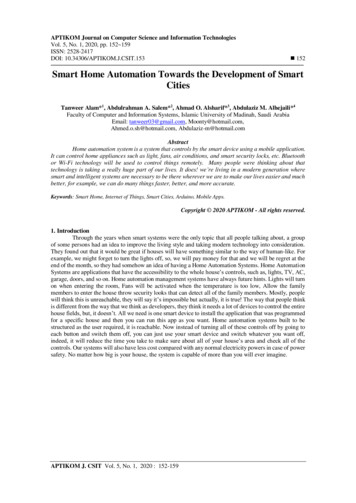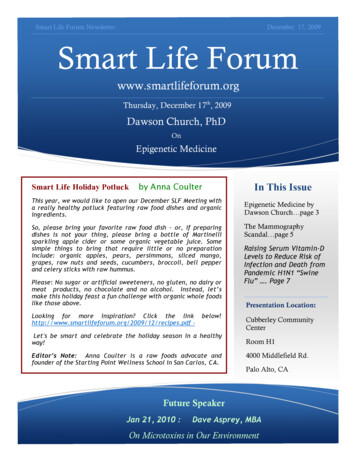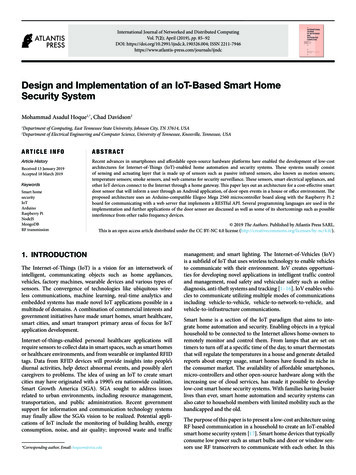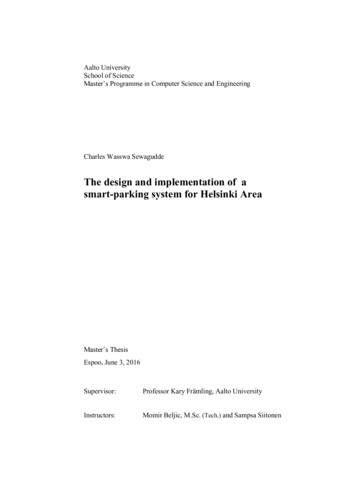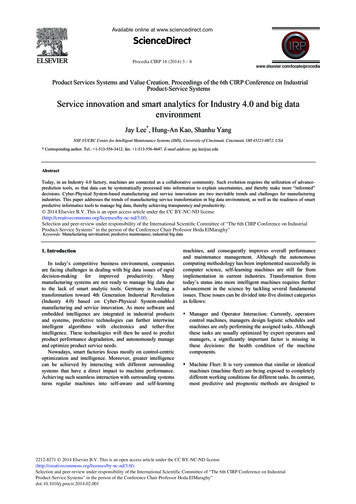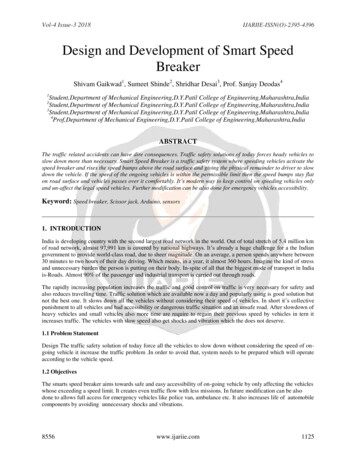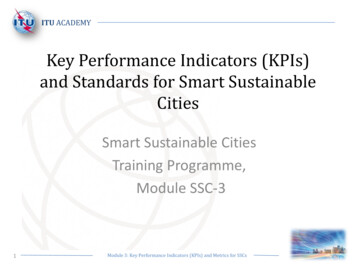
Transcription
IT 15065Examensarbete 15 hpAugust 2015Implementation and Evaluationof Smart Training GearMeasuring and Visualizing Muscle Data inReal TimeSamuel SvensäterInstitutionen för informationsteknologiDepartment of Information Technology
AbstractImplementation and Evaluation of Smart TrainingGearSamuel SvensäterTeknisk- naturvetenskaplig orietLägerhyddsvägen 1Hus 4, Plan 0Postadress:Box 536751 21 UppsalaTelefon:018 – 471 30 03Telefax:018 – 471 30 00Hemsida:http://www.teknat.uu.se/studentDuring weight-lifting exercises muscles are contracted and relaxed. Muscles to theleft and to the right of the center of the human body are each other’s counterparts—we are symmetric in relation to the center of the body and this symmetry can bemaintained if muscles are activated equally during exercises. With the help ofelectromyography, a technique to measure the electrical activity generated bymuscles, a micro controller, bluetooth technology and a smart phone muscleactivity can be measured, compared and visualized in real time. This thesisdescribes the development of a smart phone application to help weight liftersperform well-balanced exercises. The work is based on studies of weight liftersand experiments with electromyography sensors. Multiple sensors can be used tocompare muscles’ activity and the result can be a help to perform a well-balancedmuscle activation. The conclusions are that the accuracy of the measurementsvaries mainly with two factors; muscle depth and the resistance between thesensors and the human skin—superficial muscles and low resistance provide moreuseful measurements than deep muscles or high resistance between the sensorsand the skin. Real time muscle activity feedback can help to perform a balancedmovement during an exercise, but muscle depth and the resistance between thesensors and the skin are crucial for the outcome. The visualization is representedin two ways; in real time to give direct feedback and as a ten second mean toshow the activity over time.Handledare: Jon WingårdÄmnesgranskare: Mikael LaaksoharjuExaminator: Olle GällmoIT 15065Tryckt av: Reprocentralen ITC
Contents1 Introduction1.1 Background . . . . . . . . . . . . . . . . . . . . . . . . . . . . . . . .1.2 Project Stark . . . . . . . . . . . . . . . . . . . . . . . . . . . . . . .2 Hardware2.1 Arduino . . . . . . . . . . . . . . . .2.1.1 Similar hardware . . . . . . .2.2 Bluetooth Low Energy . . . . . . . .2.3 Electromyography . . . . . . . . . . .2.4 Muscle Sensor v3 . . . . . . . . . . .2.5 Wearable Technology . . . . . . . . .2.6 Results . . . . . . . . . . . . . . . . .2.6.1 Electrode Placement . . . . .2.6.2 Weight Lifting Related Issues2.6.3 Exercise Studies . . . . . . . .334.777891012121314143 Software3.1 User Experience . . . . . . . . . . . . . . . .3.2 A Process of Interaction Design . . . . . . .3.3 Hybrid Mobile Applications and Frameworks3.4 Procedure and Results . . . . . . . . . . . .3.4.1 Observations . . . . . . . . . . . . .3.4.2 Prototyping and Application Design3.4.3 Muscle Activity Visualization . . . .3.4.4 Application Flow . . . . . . . . . . .3.4.5 Evaluation . . . . . . . . . . . . . . .171717181919202022244 Analysis.255 Discussion275.1 Future Work . . . . . . . . . . . . . . . . . . . . . . . . . . . . . . . . 285.2 A Final Word . . . . . . . . . . . . . . . . . . . . . . . . . . . . . . . 28A Appendix: Hardware29References311
1IntroductionAccording to a report published in 2014, Swedes’ expenses for fitness and healthare approximately 50 billion Swedish kronor per year and over 60% of the Swedesexercise regularly [1]. Activity bands that track a user’s daily activity were theChristmas gift of the year in 2014 in Sweden [2] and according to a study [3] performed in March 2014 in the U.S, the three primary reasons for internet users touse mobile health and fitness apps were goal tracking, closely followed by awarenessof health issues and motivation. Fitness apps can motivate and inspire people tosuccessfully achieve their goals. This thesis will examine how real time muscle activity feedback can be used to understand how individual muscles behave during anexercise.1.1BackgroundThere are products available to measure biometric data, the Nike Fuel activityband for example is an advanced pedometer which can measure the number of stepstaken during a day or track the intensity of a workout using a 3-axis accelerometer [4].The activity can be visualized using a smart phone or a computer and the givenfeedback can be a way to motivate people to exercise.When muscles are activated they produce electrical signals, these signals can besensed and measured using electromyography (EMG). EMG is a diagnostic techniquethat traditionally has been used in medicine to evaluate and record muscle activityto for example discover neuromuscular diseases [5]. However the EMG technique canbe interesting for companies outside the medical sphere, to name a few companiesthat measure and makes use of biometric data:Athos [6] is a company based in California, USA, who are working on a productto gather and visualize biometric data using sensors in clothing, which they callsmart apparel. The idea is to measure muscle performance, heart and breathingrates in real time and send this data to a smart phone for visualization. To datethey have no product available to ship.Myontec [7] based in Finland offers shorts that measures muscle activity, heartrate and cadence among other performance data in real time. Their shorts, Mbody,uses EMG to measure electrical signals produced by the quadriceps and hamstrings.Thalmic Labs [8], based in Kitchener, Canada, is a company who has developeda gesture control armband called Myo that can sense electrical activity in the forearmin order to identify gestures. The activity can be transmitted to a computer, a smartphone, or any other Bluetooth compatible product.3
1. IntroductionThese products all use EMG to sense muscle activity and the idea is, for Athosand Myontec, to show how muscles respond during exercise. The Myo armband usesthe same technology but instead of showing muscle activity it can control a keynotepresentation for example using the muscles of the lower arm.1.2Project StarkThis bachelor thesis is a description of the development of a prototype, includinghardware and software, which can visualize muscle activity in real time using a smartphone. Stark is the working title for the prototype and will be used throughout thethesis to refer to it.The thesis is made for the Swedish software-company Omninova AB1 . Omninova works with projects in the digitization of health and wants to look at thepossibilities to gather biometric data from individuals to understand what this datacan be used for as well as what opportunities and obstacles the technology offers.Many people who exercise do so to improve their body strength, to lift heavyobjects more safely, or just because they feel good when endorphins are released.Stark is developed for, but not limited to, people who want to improve their weightlifting results, or to show muscle activation for rehabilitation purposes. The idea isto introduce ways to understand how muscles activate when a particular movementis performed. The prototype will be able to visualize the activity of two muscles.At the beginning of the project Omninova stated their idea with Stark: Stark isa product that can measure and visualize muscle activity in real time using a smartphone. The communication between sensors and a smart phone should preferably bewireless to make the product mobile. The app should feature activity visualizationin real time as well as over time to show how even two muscles are activated togive the users appropriate feedback for an exercise. Further it should be possible toselect muscle group to measure, these measurements should be saved as statistics.Preferably users should be able to interact with the app and start a measurementwithout external help or documentation.Questions Investigated How sensitive is the positioning of the sensor electrodes to get useful measurement data? Can Stark indicate if a weight-lifting exercise is performed in a balanced way? How should muscle data be visualized?This thesis will describe how two EMG sensors together with a smart phone appcan be used to measure and visualize muscle activity in real time.1http://www.omninova.se, Omninova AB. [Accessed 20150322]4
1. IntroductionSince this is a thesis that involves hardware and software development thechapter division might differ from other theses that are more related to literaturestudies. The first chapter covers hardware related theory, how the work has beencarried out and the results obtained during hardware studies. In the second chaptersoftware development theory, user interaction related topics and the experimentsperformed in relation to software are presented. To summarize the results from thetwo chapters a common analysis and discussion will be presented at the end of thethesis. Figures used in the thesis are created by the author unless otherwise stated.5
2HardwareTo measure muscle signals EMG sensors and a micro controller will be used. Datawill be sent using wireless Bluetooth technology to a smart phone, an Apple iPhone,where the data will be visualized. Apple iPhone was chosen since Omninova requested the prototype to run on Apple iOS.2.1ArduinoThe Arduino is a small open source computer board equipped with a micro controller. A micro controller is an integrated circuit containing all main parts of atypical computer [9]. For this project the Arduino Uno R3 board will be used whichfeatures an ATmega328 micro controller running at 16 Mhz, equipped with 32KBflash memory, 2KB SRAM, an integrated analog-to-digital converter (ADC) andanalog/digital pins for input and output. The Arduino is intended for anyone making interactive projects [10] and incorporates techniques to sense and respond to thereal analog world using sensors of various kinds. See figure A.1 for the Arduino UnoR3 board layout.Programs for the Arduino are written in the Arduino language which is similarto C. Added syntax include functions to read and write digital and analog input/output signals. External libraries can be added to any program. An Arduino programhas to contain a setup function and a loop function. The setup function is executedwhen the board is powered or when the on board reset button is pressed. The setupfunction is only executed once. When the setup function is finished the loop functionis executed over and over again as long as the board is powered.2.1.1Similar hardwareThere are other hardware available that could be of interest for a project like this.BITalino [11] is a hardware and software toolkit that has been specificallydesigned to deal with the requirements of body signals. Various sensors are includedin a kit available for purchase. The main reason why the BITalino was not chosenwas that the purchase price was higher than other alternatives.The Intel Edison [12] is a small computer with Bluetooth and WiFi chips onboard. Initially the Edison was chosen to serve as the signal handler and main devicefor Stark because of its small size and for the reason that it had both WiFi andBluetooth on board. It turned out, however, that the Edison lacked ADC which isneeded to read the output from the sensors correctly since they only output analog7
2. Hardwaredata. Even though there are external ADC boards available for the Edison theArduino was chosen as main controller since it featured ADC and for the reasonthat the sensor was known to be compatible with the Arduino and that it had beentested by the manufacturer [13].An external Bluetooth adapter will be used to transfer data wireless to a smartphone from the Arduino.2.2Bluetooth Low EnergyBluetooth is a cable replacement technology operating at the unlicensed 2.4 GHzband and can transfer data over a wireless link.Due to restrictions set by Apple on which Bluetooth technology their mobiledevices support classic Bluetooth (version 2.1) cannot be used without major configurations and certificates. Bluetooth Low Energy (BLE) is optimized to consumelittle power and to send data at low rates. BLE is supported by the Apple’s operating system iOS, as well as by the Android operating system, version 4.3 andnewer. BLE will be used for this project and is sometimes referred to as BluetoothSmart [14].The Adafruit nRF8001 Bluetooth LE adapter (see figure A.2) will be used sincethe Arduino does not have Bluetooth. The adapter can simulate a serial connectionwhere data is being sent between two devices over a wireless link.To set up a connection between BLE compatible devices they need to knowwhat other devices there are available nearby, this is called the inquiry process. Inthe case of the BLE adapter used for Stark the phone must initiate the connection.The adapter listens for incoming inquiry packets sent by the phone and repliesback. A reply contains information needed by the phone to connect to it. When aconnection has been established information can be exchanged between the devices.Technical Details The nRF8001 supports data transfer up to 10 meters to a BLE-compatibledevice. The nRF8001 sends out packets of data, 20 bytes at a time. BLE uses frequency hopping, which means that data packets are sent on different channels, to minimize interference from other technologies operating at2.4 Ghz. BLE features robustness against interference with 24 bit Cyclic RedundancyCheck (CRC) on all packets. BLE has AES-128 encryption and authentication of data packets.8
2. Hardware2.3ElectromyographyElec
select muscle group to measure, these measurements should be saved as statistics. Preferably users should be able to interact with the app and start a measurement without external help or documentation. Questions Investigated How sensitive is the positioning of the sensor electrodes to
